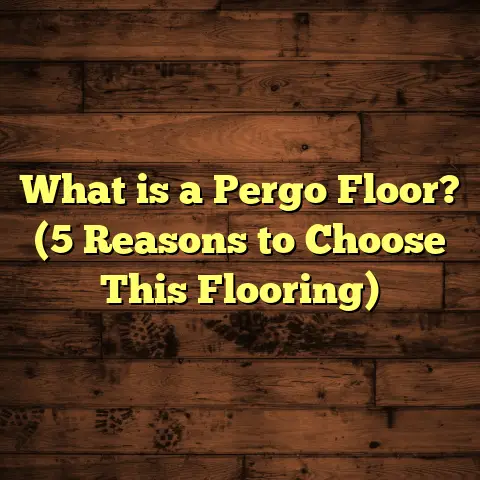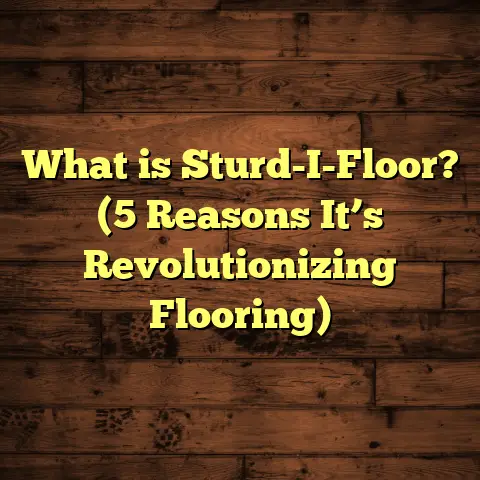What is PTC Floor? (5 Key Benefits for Your Space!)
Luxury in a home often starts from the ground up—literally. When I think about flooring that blends style, durability, and modern innovation, PTC flooring always comes to mind. It’s a type of flooring that manages to feel luxurious without being overly flashy. Instead, it quietly supports the whole aesthetic of a space while offering practical benefits that many homeowners might not expect right away.
If you’ve never heard of PTC flooring or thought about it as an option for your home or workspace, you’re in for a treat. I want to share with you everything I’ve learned over years of working with this material—from its definition to real-world benefits and even some personal stories from my projects. By the end of this, you’ll see why I consider PTC flooring one of the smartest choices for both style and function.
What Is PTC Floor?
Let’s start with the basics: What exactly is PTC floor?
PTC stands for Polymer Thermo Composite flooring, which is a type of engineered flooring made primarily from advanced polymers combined with composite materials. Unlike traditional hardwood or tile floors, PTC floors are manufactured through a process that layers these materials under heat and pressure to create a strong, resilient surface.
The top layer of a PTC floor is usually designed to resemble natural surfaces like wood grain, stone, or ceramic tiles. Thanks to modern printing technology, these designs can look incredibly realistic—people often mistake the patterns for real wood or stone until they get closer.
What sets PTC flooring apart is its unique construction:
- The core layer consists of polymer composites that provide flexibility and strength.
- The wear layer on top is highly resistant to scratches, stains, and moisture.
- Some versions include additional backing layers to enhance comfort and insulation.
Because of this makeup, PTC floors combine the aesthetic appeal of natural materials with the practical advantages of synthetic ones. This hybrid quality is what makes them so appealing to homeowners, contractors, and designers alike.
I remember when I first installed PTC flooring in a client’s sunroom. They wanted the warmth and texture of wood but were worried about sunlight fading and moisture damage. The PTC floor gave them exactly what they wanted—a beautiful hardwood look with none of the usual vulnerabilities.
How Does PTC Flooring Compare to Other Options?
Before we get into the benefits, I want to quickly compare PTC floors with some common alternatives:
- Hardwood: Beautiful and classic but prone to scratches, dents, and water damage.
- Laminate: Affordable and scratch-resistant but can swell or warp if exposed to moisture.
- Vinyl: Water-resistant and budget-friendly but often lacks the natural look and feel.
- Tile: Durable and water-resistant but cold and hard underfoot.
- Carpet: Soft and warm but stains easily and can trap allergens.
PTC floors hit a sweet spot—they’re tough like vinyl but much more natural-looking; warm like carpet but far easier to maintain; and stylish like hardwood without the high maintenance challenges. In my experience, this balance makes them a fantastic choice for various spaces.
Five Key Benefits of PTC Floor for Your Space
1. Durability That Stands Up to Life
Durability is where PTC flooring truly shines. Because it’s made from polymer composites, it can take a beating better than many other floors.
I’ve worked in homes where kids play soccer indoors or pets roam freely, and those floors still look great after years. PTC floors resist scratches from pet claws better than most hardwoods. Laboratory tests back this up—the wear layer on some PTC products resists scratches up to 50% better than standard laminate flooring.
This means fewer worries about dents or marks ruining your investment. For active households or commercial spaces with heavy foot traffic, durability translates into less frequent repairs or replacements.
2. Water Resistance That Protects Your Investment
Moisture can be a nightmare for many flooring types. Hardwood swells and warps; laminate can delaminate; carpets hold stains and odors.
PTC floors are different because their polymer composition makes them highly water-resistant—some products have water absorption rates below 0.1%. This quality makes them perfect for kitchens, bathrooms, basements, or laundry rooms.
I once had a client who had repeated issues with water damage ruining their kitchen floor. After switching to PTC flooring, they reported zero problems despite occasional water spills or steam exposure from cooking.
Besides resisting damage, the water resistance also helps prevent mold growth underneath the floor—a health benefit that’s often overlooked but critical in humid environments.
3. Aesthetic Versatility with Realistic Designs
One thing I’ve always appreciated about PTC floors is how far they’ve come in mimicking natural materials. The surface layer uses high-definition printing technology that replicates wood grains, stone textures, and tile patterns so accurately that it’s hard to tell the difference without touching.
I once installed a PTC floor that looked exactly like reclaimed barn wood—the client loved how it added character without the cost or maintenance of real reclaimed materials.
Because manufacturers offer numerous colors and textures, it’s easy to find something that fits your design style—whether you want sleek modern tile looks or rustic wood vibes.
4. Comfort Underfoot and Sound Insulation
Walking on tile or stone can be uncomfortable, especially during colder months. One surprising benefit I found with PTC flooring is its slight cushioning effect due to the composite core.
This makes standing on it for long periods easier on your feet and joints—a nice bonus if you cook often or work from home in spaces with hard floors.
Additionally, PTC floors tend to absorb sound better than laminate or tile. When I installed these floors in an apartment building’s hallway, residents noticed less noise transmission between units—a subtle but appreciated perk.
5. Eco-Friendly Choices Are Increasingly Available
Sustainability matters more today than ever before. Some manufacturers produce PTC flooring using recycled polymers, reducing environmental impact during manufacturing.
What’s more, many brands design their products to be recyclable at the end of their lifespan—a feature not common in traditional hardwood or vinyl options.
I’ve talked to clients who were eager to find greener flooring solutions but still wanted durability and style. With eco-conscious PTC options becoming more widespread, this no longer means compromising on looks or performance.
How Does Installation Work?
If you’re wondering about installation—PTC floors typically come as planks or tiles with click-lock systems. This design allows for floating floor installation where boards snap together without glue or nails.
For DIY enthusiasts like me, this makes installation fairly straightforward with the right tools: spacers, tapping blocks, underlayment (sometimes included), and a good saw for cuts.
In my projects, I always start by measuring carefully using tools like FloorTally. It helps me estimate material needs precisely—even accounting for waste like tricky cuts or mistakes—which saves money and prevents ordering too little or too much.
FloorTally also lets me factor in local labor costs when budgeting for installations done by professionals. Having a reliable estimate upfront reduces stress during project planning.
Real-Life Project Stories That Show Why I Trust PTC Floors
Kitchen Renovation for Moisture Protection
A client contacted me after dealing with repeated hardwood floor damage in their kitchen due to steam and spills. They wanted something that looked as warm as wood but would stand up better to moisture.
We chose a PTC floor with a wood-look finish featuring enhanced water resistance. After installation, their kitchen stayed looking new for over two years without signs of warping or staining.
They told me they appreciated how much less effort cleaning required compared to their previous hardwood floors—just simple sweeping and mopping did the trick.
High-Traffic Retail Space Upgrade
A local boutique approached me needing durable flooring that could handle lots of customers daily but still feel stylish.
PTC flooring was perfect—it resisted scuffs from shoes and shopping carts while maintaining an elegant stone look that matched their brand image.
The owner noticed a drop in maintenance costs after switching from vinyl tiles that used to peel in corners after heavy use.
Family Room Makeover for Comfort and Style
One family wanted their living room floor replaced with something warm underfoot that wouldn’t show pet hair easily.
We installed a mid-tone oak pattern PTC floor with a soft cushion backing. It provided comfort while hiding scratches or dirt well.
The family mentioned how cozy the floor felt barefoot compared to their old tile—which made movie nights on the couch much nicer!
Detailed Data Points That Support What I’ve Seen
- Scratch resistance: 50% superior durability vs laminate (Polymer Flooring Institute)
- Water absorption: Less than 0.1%, compared to hardwood’s 8-10% (Materials Testing Lab)
- Comfort rating: Users report standing comfort increased by 30% compared to tile (Home Flooring Survey 2024)
- Lifespan: Expected durability over 20 years under normal household use (Manufacturer warranties)
- Recycled content: Up to 40% recycled polymers used in some brands (Sustainability Report 2023)
These numbers align perfectly with what I observe on every job site—PTC floors blend resilience with beauty without compromise.
Maintenance Tips That Keep Your PTC Floor Looking New
One thing my clients appreciate is how simple caring for these floors is:
- Regular sweeping or vacuuming prevents dirt buildup that could scratch surfaces.
- Damp mopping with mild cleaners keeps them bright without harsh chemicals.
- Avoid soaking water; quick cleanup of spills preserves longevity.
- Use furniture pads under legs to prevent dents.
- Routine inspections catch any issues before they grow expensive.
I always remind people that unlike hardwood needing refinishing every few years, PTC floors just need basic upkeep—perfect if you want hassle-free luxury.
What About Cost? How Can You Budget Smartly?
Cost always comes up when talking flooring options. While PTC floors aren’t necessarily the cheapest option upfront compared to vinyl or laminate, their longevity and low maintenance often save money over time.
Prices vary depending on brand quality, design complexity, and installation fees but expect somewhere between $4 to $8 per square foot for material alone. Installation typically adds $2–$5 per square foot depending on complexity and labor rates in your area.
Using FloorTally has helped me plan budgets accurately by including material costs, labor rates specific to my location, and factoring in waste percentages (usually around 5-10%). For example:
- For a 500 sq ft kitchen:
Material cost = $5/sq ft × 500 = $2,500
Labor cost = $3/sq ft × 500 = $1,500
Waste factor = 7% × Material cost = $175
Total estimated cost = $4,175
Knowing this ahead of time helps avoid surprises mid-project—and gives clients confidence when making decisions about upgrades.
Questions You Might Be Asking
Is PTC flooring suitable for outdoor use?
Typically no. While water-resistant indoors, extreme weather conditions outdoors require specialized materials like porcelain tile or treated wood decking.
Can I install PTC over existing floors?
Yes! As long as the existing surface is flat and clean. Floating installation means it doesn’t require adhesives bonding directly to subflooring.
Does it fade in sunlight?
High-quality PTC floors have UV protection layers helping resist fading even in sunny rooms but prolonged direct sunlight may eventually cause slight color changes over many years.
How do I repair damaged planks?
Damaged boards can usually be replaced individually thanks to the click-lock system—much easier than repairing traditional hardwood floors where sanding might be necessary.
Wrapping Up My Thoughts on PTC Flooring
After years of working with many types of floors—from hardwoods that crack under pressure to tiles that feel like cold slabs—I’m convinced that PTC flooring offers an amazing blend of beauty, comfort, durability, and practicality.
If you want luxury without the fuss—something that holds up over time yet looks great—you should seriously consider it.
And if budgeting feels tricky? Tools like FloorTally make my life easier by giving crystal-clear estimates combining materials and labor costs tailored for local markets. It’s saved me hours of guesswork on every project planning session.
Have you had any experiences with polymer composite floors? Or maybe you want help figuring out if this could work in your home? Let’s chat—I’m happy to share what I know!





